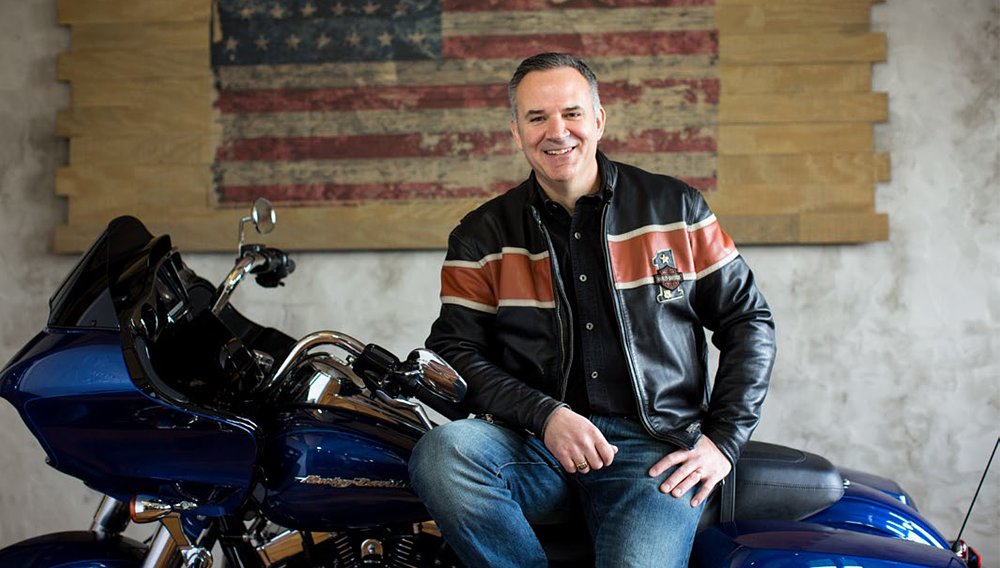Using the classic “5 p.m. on a Friday news release” tactic employed globally by public relations experts who have to release some news they would rather nobody notice, Harley-Davidson announced that CEO Matt Levatich is out of a job.
Levatich pounded the table as hard as he could in his five years as CEO, arguing both publicly and internally that Harley-Davidson had to change. The “More Roads to Harley-Davidson” strategy was aimed at making Harley a company that built riders, not built motorcycles, Levatich said over and over, both publicly and internally. Still, it takes a long time to turn around a company with such a deeply entrenched image as Harley-Davidson and attract new and different customers to replace the aging, white male Baby Boomers who were Harley’s “core customers” during the good years and are now aging out of motorcycling.
Levatich faced multiple headwinds and a few unexpected gales, which I’ve written about before and won’t repeat in detail: the general decline of the U.S. motorcycle market, the unfavorable demographic trends, trade-war tariffs that forced it to move more production overseas and angry tweets from the White House in response. As a result, it’s not surprising that Harley’s sales declined steadily during Levatich’s five years as CEO.

Despite his efforts to turn around the company, sales declined steadily at Harley-Davidson during Matt Levatich’s years as CEO. Harley-Davidson photo.
The company responded first by building smaller, world-market motorcycles (though I found them to be unimpressive, as did most reviewers), and then made even bigger and bolder moves by announcing a range of new models that shifted the company beyond its traditional base of heavyweight cruisers (the U.S. market segment that declined fastest in 2019, by the way). It even announced a partnership with a Chinese company to build more inexpensive bikes for the Asian markets, where motorcycles actually sell in big numbers, unlike the United States.
Of course the real question now is whether the departure of Levatich means the board of directors has decided to reject his strategy and change course. Some people are speculating that the company will do what it did in the 2008 financial crisis, when motorcycle sales in the United States plummeted by half. Harley-Davidson shuttered Buell and dumped MV Agusta, which it had acquired, at a loss. Like a turtle pulling back into its shell, Harley got rid of its non-traditional models and doubled down on the plan to sell heavyweight cruisers to its same base of aging customers. Will it do that again?
I have little confidence that the new models Harley-Davidson has announced will be a huge success, for reasons I’ve stated before, and I also think the company still has lots of internal attitude adjustment to do. But, I can’t believe that the Harley board could consider doing the turtle move again. A turtle shell may provide a feeling of comfort and safety, but it’s not a dynamic place. Harley-Davidson has already closed its Kansas City plant and shifted production overseas and history has shown that companies cannot shrink and cost-cut their way to profitability and success.
Jochen Zeitz is acting CEO at Harley-Davidson now and will be chairman of the board. He is a German businessman who became the CEO of PUMA at the record-setting age of 30 and turned around that struggling company. I can’t imagine a man who is best known for a corporate turnaround and a 4,000 percent increase in the stock price of his company deciding that the strategy now is for Harley to go back to building different colors of Low Riders for customers who are increasingly trading in motorcycles for mobility scooters. As skeptical as I am of Harley-Davidson, I have to believe they’ll continue ahead on some course of corporate change, even if it’s not the exact same course Levatich charted.
One other interesting piece of motorcycle news this week out of Milwaukee: There are only two motorcycle company CEOs in that city and both left their jobs. Rod Copes, CEO of Royal Enfield North America, also stepped down. Copes is a former Harley-Davidson executive who was hired by Royal Enfield (one of the largest motorcycle companies in the world but mostly limited to the huge India market) to lead the effort to establish the brand in the United States, and he made a lot of progress. Will we see Copes return to Harley-Davidson? I wouldn’t be surprised.

Interesting you chose the Low Rider, they make far more popular and historic models, such as the Electra Glide or Softail. Since they decided to make the Trikes for their aging customers, would it really be that much of a stretch to see the MoCo offer candy apple red, two-tone mobility scooters?
I doubt there’s as much margin in mobility scooters as in big cruisers.
The mere thought brings to mind the old golf cart days, no?